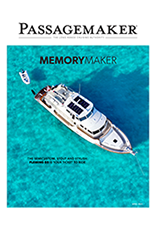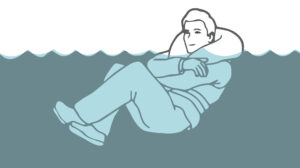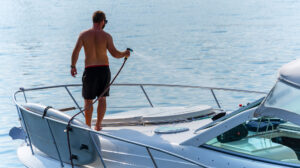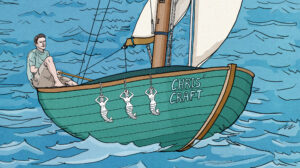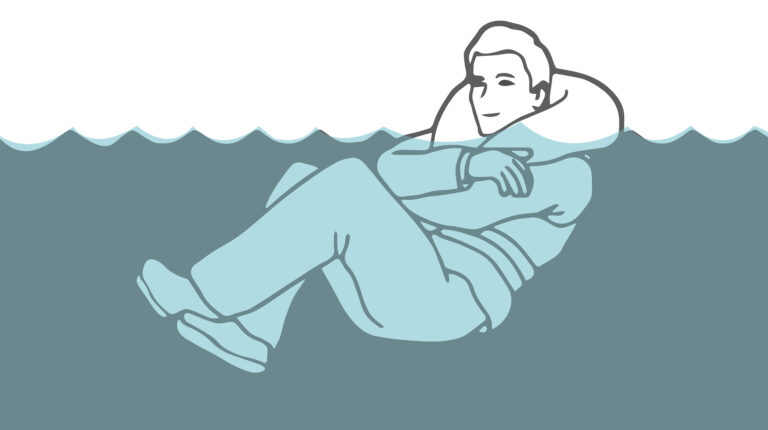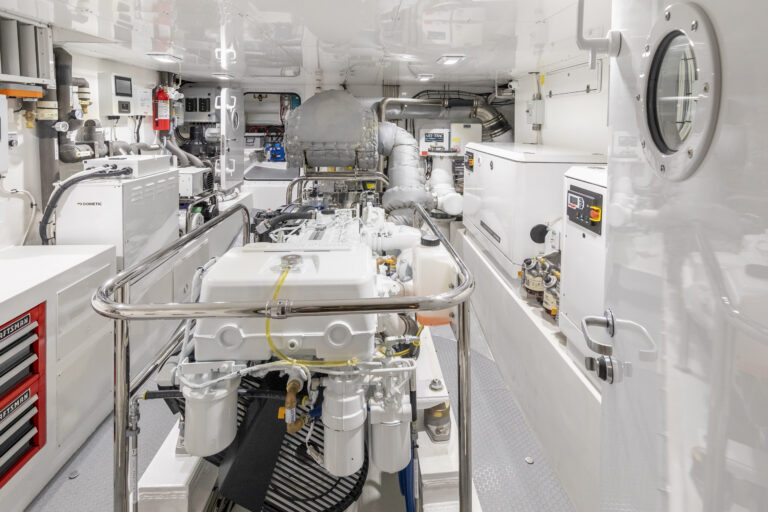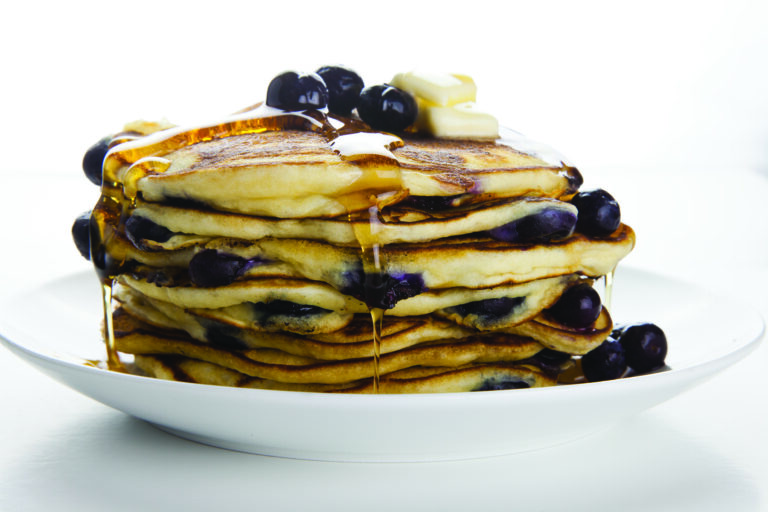Over the past forty-seven years my husband Bob and I have cruised sailboats to many different parts of the world. Never in our wildest dreams, however, had we envisioned buying a cruising motorboat, much less living in one that was carried through bluewater at fourteen knots on the deck of a five-hundred-sixty foot ship.
We arrived at this juncture in our life when Bob exclaimed, “let’s buy a trawler!”
What he had in mind was a specific kind of trawler-fiberglass, less than fifty feet long, a stand-up engine room with safe, easy access, and two diesel engines. After looking over the boats that most closely fit our needs, we found that the boat we really wanted was a 46-foot Cheoy Lee trawler, made from 1978 through 1982.
How Would We Get It Home?
Now the snare. We live in the San Francisco Bay area, and the five boats on the West Coast were not for sale. There were four boats for sale in North America, but back on the East Coast. This presented a bit of a logistical problem to say the least. If we bought a boat thousands of miles away on the East Coast, how were we going to get it to San Francisco?
Our broker gave us the names and numbers for several trucking companies, which we explored first. Given the size of the Cheoy Lee, 46′ LOA, beam of 14′ 8″, 27 feet tall, and weighing in at 51,000 pounds, one company told us they couldn’t do it, and another trucking company said they could take it out of the water in Freeport, Texas, and transport it to San Diego. That would cost $22,000, but didn’t cover the preparation of taking it out, or the cost of taking it off the truck. Worse yet, all the fuel would have to be emptied out. The reason for this excessively high cost was that the truck would have to have a highway patrol escort through several states.
“Strike that one out,” I said.
We looked into transport by rail, but the boat would be too wide. Next came the thought of shipping it as deck cargo onboard an American freighter. A friend of ours in the shipping business said his freighters could do it, but it would have to be billed as to how many shipping containers it would displace. He figured seven containers due to height, width, and length, which would cost $75,000. My heart stopped. Grey is not a good color for my complexion. “There has got to be something else by water,” Bob said.
Learning About Super Servant
Our broker called one day and told us, “United Yacht Transport is what you want. They can take you from Florida to the west coast of Mexico.”
When Bob didn’t answer right away the fellow added, “You and Marlene can make a great trip of this. I wish I could go.” Good salesman.
Bob called United Yacht Transport in Fort Lauderdale and it turned out their regular schedule for 1998 served Fort Lauderdale; St. Thomas; Palma de Mallorca, Spain; Lazzaro Cardenas, Mexico; and Papeete, Tahiti.
We learned a Dutch company called Dockwise owns the United Yacht Transport ship. They have one ship dedicated for yacht transport, the 560-foot Super Servant 4. Dockwise operates thirteen other similar semisubmersible ships for transporting cargo, such as fully assembled container cranes, and barges loaded with oil-well drilling pipes.
It’s an impressive operation, and made sense to us, even if our pocketbook gagged at the US$20,000 estimated for the trip. But we didn’t even have a boat at this point, although we were encouraged enough to call our broker to make arrangements to see the boats back east.
We Find Our Boat…Now What?
We quickly ruled out a boat in Connecticut and another in Florida because of high prices. Then we flew out to look at a Cheoy Lee in Detroit. The fourth boat was in Camden, Maine, but we ended up buying the 1979 Cheoy Lee in Detroit.
After collecting sea songs for fortyseven years, we renamed her Sea Chantey. We originally decided to bring her all the way back home by water, and Bob’s attitude was, “No problem, let’s make a little trip out of it. Maybe we’ll bring the boat back to California ourselves. Think of the great experiences we’ll have traveling through eighteen states by water.”
But the more we thought about the time factor, cooler heads prevailed. Super Servant 4 took a four-thousand mile direct route from Fort Lauderdale, passed between Cuba and Haiti, down to the Panama Canal, up the west coast to Lazaro Cardenas, Mexico. In total, it would take a total of eleven days.
If we took the boat from Florida to Mexico ourselves we would have to go the long way, staying near the United States coast, over to Mexico, Columbia and work our way down through the Panama Canal and follow the coast up past Costa Rica, Central America, Mexico. It would be miles and miles, all at seven knots. We calculated our twin 120 Ford Lehman diesels burned four gallons per hour at sixteen hundred rpm. Based on four thousand miles, the short distance, we would use two thousand gallons of fuel, costing upwards of $3000. The four-thousand miles would also mean 570 hours on the engine, which equates to six oil changes, 156 quarts of oil, and 12 oil filters. Plus, there would be oil filters on our double Racor filter system, 24 fuel filters, and spare parts such as raw water pumps, oil coolers, transmission coolers.
In all, it would be hard wear and tear on the boat and us. Also, there would be the cost of food, sight seeing, Panama Canal transit, checking in and out of countries, the cost of our private boat insurance ( which would not cover us anywhere near Guatamala), and weatherrelated problems associated with El Nino and La Nina, plus the usual hurricanes.
The combined obstacles could easily stretch the trip into two years, costing as much what we would spend on Super Servant. So the decision was made, and we opted for using United Yacht Transport.
A Plan Comes Together
The ship’s departure date of early February 1998, fit into our time schedule. It also gave us breathing room between our own schedule of leaving in early June 1997 from Detroit, through the Great Lakes, Oswego and East Erie Canals, Hudson River, through Long Island Sound, and along the Atlantic coast.
Then, a haul out in Connecticut for stabilizers and a bottom job, southwest down through the Chesapeake, then join the inland ICW waterway from Norfolk, Virginia to Florida.
Joining Super Servant 4 in Florida, it would be eleven days to Mexico. We’d spend part of February, March and April in Mexico, with all of May bringing us home to San Francisco.
Suddenly my bones felt very tired. Those same joints had earlier cruised Mexico, Marquesas, Tuamotus, the Society Islands and Hawaii to San Francisco by sailboat. The last two years were spent cruising in Canada and Alaska, and now this rather elaborate trip emerged on the horizon. I sat in a chair, and abruptly thought of an old Will Rogers’ saying, “Even if you are on the right track, you’ll get run over if you just sit there.”
I smiled when I realized time continued ticking away, whether we sat in a chair reading about life, or lived life to its fullest on a seat in our trawler’s pilothouse. We now had the opportunity to choose a new track, and go piggy-back besides.
As it turned out, there was room to take Sea Chantey on the February trip from Fort Lauderdale to Lazzaro Cardenas. The ship would take a total of sixteen passengers, each living aboard their own boat. The cost would be $20,000, and include three meals a day taken with the crew, beer, the use of the recreation room with television and VCR, shower, washing machine and dryer, electrical connection from our boat to the ship, water, waste disposal, and custom clearance handled by a United Yacht Transport appointed custom agent. The only extra charge we would have to pay would be for Marine Cargo Insurance, based on the agreed value of our boat of $150,000, costing us $240. (The premium has remained low because of the company’s good record during the eight years they had been transporting yachts, with repeat business accounting for forty percent of the company’s business.)
We learned the largest yacht transported by the company measured 240 feet, the smallest, 17 feet. Prior to the sailing date, the company wanted drawings of our boat in order set up keel blocks to match each boat’s bottom profile. We sent pictures of our boat bottom out of the water, along with our deposit of $3,000.
At last February arrived, but when we checked into the office of UYT we were told the ship had been delayed in France for a week because of a huge winter storm. The rough water had prevented the safe loading of yachts. The ship finally departed France with forty-four yachts, stopping in Guadalupe to off load some of the boats.
Getting Aboard Super Servant 4
February 11 arrived and we headed toward Port Everglades in the late afternoon. Soon the large profile of Super Servant 4 came into view. A flotilla of sailboats clung to her starboard side, each bearing the home port of Papeete on their sterns. They were headed to a charter company in Tahiti.
Two sixty-foot steel commercial fishing boats were secured forward on the deck, the only boats aboard on the dry surface. Their homeports read, New Caledonia. We could see that different keel blocks had been set up along the decks for each expected boat.
While we drove back and forth near the ship, we watched as the once dry deck of Super Servant begin to flood with sea water, the massive ship settling lower in the water like a hen covering her clutch of eggs. Once the water proved deep enough, the radio crackled out instruction to other boats to motor in and tie up to either the starboard or port outside rail, or port and starboard to the middle rail.
We jumped when we heard Sea Chantey’s name, following instructions to go to the middle section for a starboard tie. We motored slowly in, passing bow and stern lines to the waiting hands of the crew. Divers moved below us checking the blocks, then added temporary side blocks similar to those used in boat yards. Bubbles and tips of snorkels encircled other boats. Our heads wagged from side to side so as not to miss seeing the rest of the twenty-four vessels get organized and settled.
By nightfall all the boats were snuggled up to rails. The largest yacht was 115′ LOA, another was an older, 90-foot research vessel purchased by Mendocino State College from the University of Miami.
Not all boats had passengers aboard, and only three had their owners. A French couple in the 44′ trawler in front of us was headed for New Caledonia to start a new life. They would be off loaded in Papeete. The trip to New Caledonia was a long way, so they planned to run one engine at a time to minimize fuel consumption.
The 39′ catamaran behind us cruised with its new owner, who planned to take it to Seattle and liveaboard with his wife and four-year-old daughter. Two of the other passengers on Super Servant 4 were friends of owners, the rest were professional delivery captains in charge of large sport fishing boats. There were thirteen passengers in all.
Exploring The Ship
We were anxious to get off our boat and onto the narrow catwalk and get a better view of the operations around us. Moving around the ship’s catwalk rail was a lesson in caution and agility for a couple of seniors. It proved once again that getting old is not for sissies.
A quick look around told us this was indeed a working ship with utilitarian facilities, one bathroom with a shower, a recreation room with games, TV, VCR, two commercial washers and dryers. One washer read, “No oily clothes.”
We located the dining room where we would take our meals with officers and crew. After a gigantic lunch, I realized that one hungry woman did not match up to muscled, hungry crew. If I continued to eat this good, hearty food, at the end of eleven days I would have to be off loaded in a cargo net.
When we returned to our boat we found the crew had secured heavy woven nylon straps from our fore and aft deck cleats to the catwalk rail. We ran our generator for a while to keep up the batteries until we could hook up to the ship’s electrical system.
Once the sea water was pumped out, the ship’s electrician would take our electrical cord and hook up the ship’s power, most boats needing two 50-amp circuits, while we only used one 30-amp circuit. He would also connect a hose to the waste system plumbing on boats that had people aboard. Sea water hoses would also be connected to those boats with air conditioning.
We obtained fresh water daily from the ship’s evaporator system from eight in the morning to five in the afternoon, and were allowed to wash down our boat three times a day.
We looked wistfully at the boats with air conditioning. All we had was an oscillating fan, which felt quite pitiful at times.
The next day at noon the divers had finished their job, and the sea water was pumped out. While the hot Florida sun quickly baked the deck dry, a beehive of activity took place on all parts of the main deck. Workmen arrived from Ft. Lauderdale to completely shrink-wrap the 115-foot yacht, leaving only a small entrance/exit for the yacht engineer who was traveling with the boat to Papeete.
A crane operator picked up large crates of food, bottled water, soft drinks, beer, welding supplies, tools, and spare parts from the pier to the ship. This lasted several hours. Later more of the ship’s crew scrambled across the deck, pushing heavy carts with arc welding equipment.
One man stopped at our boat, set up his welding equipment, and pulled down his face mask. Blinding orange-blue light sparked from the rods, permanently binding large steel boat supports to the ship’s deck and snugged up next to both sides of our hull. The temporary side blocks put in by divers were then removed, and the ship’s crew began dragging rolls of heavy-extra-wide nylon strapping to each boat. They attached one end of the strap to a permanent ring welded to the deck, then pulled the strap across our boat and secured it to the catwalk, locking us firmly in place. Even with the roll of the ship at sea, we were there to stay.
An aluminum ladder was placed by each boat, tied at the top, and welded at the bottom to the deck. When the ship sailed, passengers would not be allowed on the high catwalks, and we would climb down our boat ladder to the ship’s deck, walk several hundred feet to where three flights of steel stairs led up to the dining area. After a while I developed calluses on my palms from gripping the rails.
The following night the ship sailed. The 560- foot Super Servant 4 moved slowly through the channel markers, headed out to sea. The bright lights of the city soon faded, folding most of the ship in peaceful darkness.
The next morning at breakfast we heard a couple of people talking about hiring the ship’s crew during their off hours to work on their boats. The tantalizing words that caught our attention were, “You can negotiate a price per hour, maybe $10.”
As we climbed back on our boat we looked at the yellow stain on our hull from traveling the Erie Canal. So that afternoon we hired two of the crew to clean, polish, and wax the hull and topsides. While Bob worked on wiring up new light fixtures I applied new bottom paint on the scratched areas where we touched bottom in the Chesapeake and ICW.
The next day everyone was required to bring his or her life jacket and come to the bridge. The Captain introduced himself, the officers, and explained the procedure for an abandon ship drill. He demonstrated how to used the crane and launch a twenty-six man life raft overboard. The safety officer checked everyone’s life jacket, flunking many, including ours. We had Coast Guard approved jackets, but they were not acceptable to the ship safety officer. We were loaned offshore life jackets for the duration of the trip.
The Routine At Sea
Time went by quickly, and we were never bored. Life buzzed around us as the ship headed for Cuba, turning and going between Cuba and Haiti, heading for Panama. The beam seas gave the ship a lazy roll, which made us walk a little like drunken sailors on deck.
Before we knew it we were at the first lock of the Panama Canal. Our ship took on fifteen Panamanian line handlers and two pilots. We were told to lock up our boat as things mysteriously disappeared when the line handlers left the ship. All the passengers were up and about, putting film into cameras, climbing the many flights of stairs to the deck about the bridge where the view would be the best.
We watched the ship move inch by inch into the lock, tying up, then having a sailboat come in behind us. Next to us the sailboat looked like a tadpole lost in a huge pond. We waited for the lock to fill. Our ship barely fit in, leaving little space on either side. We watched another huge container ship lock up ahead of us in a side by side lock. The relentless sun sucked out all the moisture in our bodies, and even with a hat we could not stay long on the top deck. Instead, we huddled two decks down where we found shade from the ship’s overhang. The fascinating trip through the canal took nine hours.
Our ship passed under the last bridge and we were now on the Pacific side. The crew let down two anchors, waiting for a fuel barge to tie up to us. Meanwhile a man in a white coverup sprayed insect poison in the puddles of water on the deck, in case a mosquito carrying Dengue fever had dropped by. Very efficient and quite an education.
Time continued to pass quickly as we worked inside our boat; I painted the inside of the deck locker, and washed the cushions on the seats until they were white again. Bob strung wire in the pilothouse so we could tell immediately the condition of our main batteries.
The one drawback of Super Servant 4 was the war between soot from the ship’s exhaust and our cabin windows and our deck. The sun fought a mighty battle to throw light through the glass as I scrubbed each window twice. I came to understand why shrink wrapping was used by some. The boat Captains worked diligently to keep the greasy soot on the deck from being tracked inside the boat. Not an easy task.
Arriving In Mexico
After three more days we arrived in Lazaro Cardenas, a steel port. All passengers were summoned to the Captain’s recreation room to meet with immigration.
The immigration officers were used to dealing with freighter captains, or professional licenced captains and crew. The officer did not understand why Bob did not have a Captain’s licence like the professional captains on the sportfishing boats. Bob finally told him he had been in the USA Navy and knew how to handle a ship. Which, actually was true.
All the boats leaving Super Servant 4 and going into Mexican waters had to pay US$200 for a boat import licence. Even though we would be in Mexico under four months, we had to pay for a licence that would be good for twenty years.
On Our Own Again
The process of getting off Super Servant 4 was the reverse of our experience in Florida, and it was no time before we floated free.
Once off the transport ship we headed north for Las Hadas, near Manzanillo. Giant swells rolled under us, and the bays we thought we might stop in, were inhospitable. We had no choice but to continue on for twenty-four hours until we reached our destination. This seemed harder than the twenty-six day passage to the Marquesas in our sailboat twelve years before. “But let’s face it,” I grumbled, “we were younger then.”
While Bob stood watch, I measured the seas, thinking one of the first things I wanted to buy was a good, offshore life jacket. Mentally, I had got used to the one we had borrowed.
From this point on we would be singing more than just sea chanties. We would have to add, “California here I come, right back where I started from.”
Reprinted with permission. Copyright 1999 © Dominion Enterprises (888.487.2953) www.passagemaker.com
